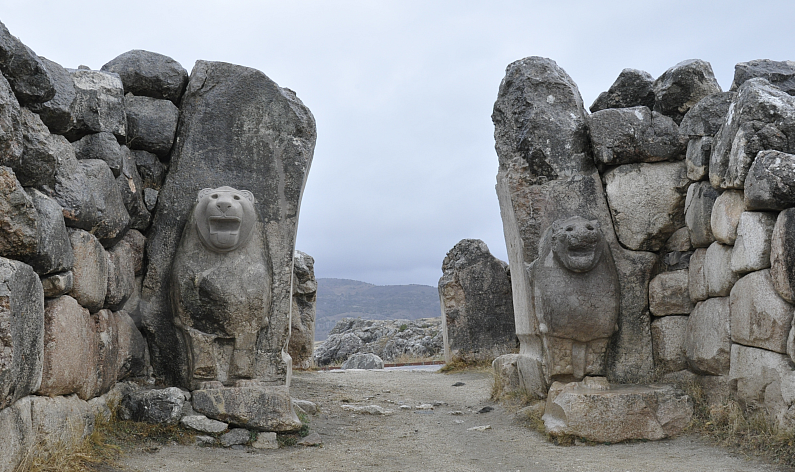Archaeologists discover previously unknown ancient language
Discovery helps reveal how a long-lost empire used multiculturalism to achieve political stability
Archaeological research in the Middle East is revealing how a long-forgotten ancient civilisation used previously undiscovered linguistics to promote multiculturalism and political stability.
The ground-breaking discoveries are also shedding new light on how early empires functioned.
Ongoing excavations in Turkey – in the ruins of the ancient capital of the Hittite empire – are yielding remarkable evidence that the imperial civil service included entire departments fully or partly dedicated to researching the religions of subject peoples.
The evidence suggests that, back in the second millennium BC, Hittite leaders told their civil servants to record subject peoples’ religious liturgies and other traditions by writing them down in their respective local languages (but in Hittite script) – so that those traditions could be preserved and incorporated into the empire’s highly inclusive multicultural religious system.
So far, modern experts on ancient languages have discovered that Hittite civil servants preserved and recorded religious documents from at least five subject ethnic groups.
The latest example was unearthed just two months ago. It turned out to be written in a previously unknown Middle Eastern language that had been lost for up to 3,000 years.

Over the decades, around 30,000 complete and fragmentary clay tablet documents have been unearthed in the ruins of the ancient Hittite capital – Hattussa (now known as Bogazkoy) around 100 miles east of modern Turkey’s capital, Ankara.
The great majority were written in the empire’s main language – Hittite. But the Hittite government’s scribes wrote around 5 per cent of them fully or partly in the languages of the empire’s minority ethnic groups – peoples like the Luwians (south-eastern Anatolians), Palaians (from part of north-west Anatolian), Hattians (central Anatolians) and Hurrians (from Syria and northern Mesopotamia).
The most recently discovered minority language, recorded by government scribes (and previously unknown to modern scholars) is being called Kalasmaic – because it seems to have been spoken by a subject people in an area called Kalasma on the empire’s northwestern fringe.

The discovery suggests that even the most obscure languages in the empire were being recorded, studied and preserved in written form. That in turn raises the possibility that other small previously unknown Middle Eastern languages will be discovered, recorded on Hittite imperial clay tablets, in the particular series of ancient scriptoria that the archaeologists are currently excavating at Bogazkoy.
The empire’s civil service scribes wrote all their manuscripts in a Hittite version of a pre-existing Mesopotamian-originating script (the oldest writing system in the world) called cuneiform, consisting of wedge-shaped lines arranged in groups representing syllables.
The area of the Middle East which is now Turkey was, in ancient times, particularly rich in languages.
Linguistic diversity often depends on topography. The more mountains and isolated valley systems, the more languages are likely to develop and survive.
At present only five minority languages are known from the Bronze Age Hittite empire – but in reality, given the mountainous topography, there may well have been at least 30.
Indeed, just adjacent to the ancient Hittite Empire were the Caucasus mountains region which still today boasts some 40 languages.
The Hittite language is the world’s oldest attested Indo-European tongue.
The earliest inscriptions date from the 16th century BC. As an Indo-European language, it is related to most modern European languages (including English) as well as many Asian languages (including Iranian and many Indian ones). Indeed, despite the 3,000-year time gap, ancient Hittite and modern English have dozens of words in common.
Watar was for instance Hittite for “water”. Duttar was the main part of the Hittite word for “daughter”. “Wine” was wiyana, while card was “heart/cardiac” and newa was their word for “new”.
The excavations of the ancient scriptoria in Bogazkoy will allow linguistics experts to better understand the evolution of ancient Bronze Age Indo-European languages that English is distantly related to.
The current excavations are being directed by professor Andreas Schachner of the German Archaeological Institute in Istanbul – with the study of the texts on the clay tablets being undertaken by paleo-linguists from Wurzburg and Istanbul universities.
“Bronze Age Middle Eastern history is only partly understood – and discovering additional clay tablet documents is helping scholars to substantially increase our knowledge,” said cuneiform script expert, Wurzburg University professor Daniel Schwemer, who is leading the investigation into the newly discovered texts.

The excavations at Bogazkoy are currently yielding between 30 and 40 new cuneiform tablets or tablet fragments every year. Bogazkoy (ancient Hattusa) is particularly important because, as the centre of the Hittite empire (around 1650 BC to 1200 BC), it was the capital of one of the world’s first half dozen really large imperial political systems. It was therefore home to one of the world’s first really substantial document-producing civil services.
The Hittite empire stretched from the Aegean Sea in the west to what is now northern Iraq in the east and from the Black Sea in the north to Lebanon in the south.
The civilisation fundamentally changed human history – because its technological innovations (especially the use of iron, the development of sophisticated ultra-lightweight war chariots and the creation of a substantial civil service) enabled an expansion of warfare and government and the creation of ever-larger empires.
The ongoing archaeological research at Bogazkoy is shedding remarkable new light on how Hittite civilisation functioned – and thus on how it helped transform human history.
Join our commenting forum
Join thought-provoking conversations, follow other Independent readers and see their replies
Comments
Bookmark popover
Removed from bookmarks